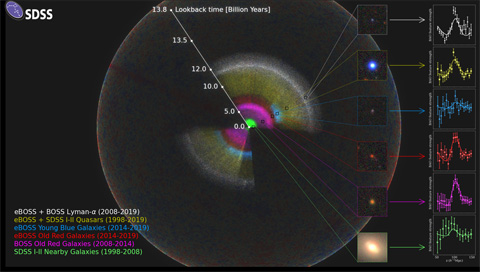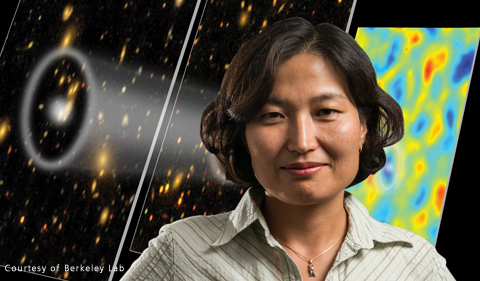
The SDSS map is shown as a rainbow of colors, located within the observable Universe (the outer sphere, showing fluctuations in the Cosmic Microwave Background). We are located at the center of this map. The inset for each color-coded section of the map includes an image of a typical galaxy or quasar from that section, and also the signal of the pattern that the eBOSS team measures there. As we look out in distance, we look back in time. So, the location of these signals reveals the expansion rate of the Universe at different times in cosmic history.
Except from Ohio University News
The Sloan Digital Sky Survey (SDSS) released today a comprehensive analysis of the largest three-dimensional map of the universe ever created, filling in the most significant gaps in the possible exploration of its history, and Ohio University researchers played key roles.
The highlights of the research include:
- Filling in the adolescent picture of the universe, the 11 billion years of cosmic time between the universe’s infancy and today.
- Getting detailed measurements of more than 2 million red and blue galaxies along with bright quasars.
- Mapping the complete expansion story of the universe, which began accelerating 6 billion years ago — and mysteriously continues to accelerate.
- Finding evidence for Einstein’s General Theory of Relativity and dark energy, but a 10 percent discrepancy with the “Hubble Constant.”
- Revealing the geometric curve of the universe and finding it to be flat.
- By the numbers: 20 years of Sloan Telescope data, more than 100 astrophysicists from around the world, and more than 20 scientific papers released today.
“We know both the ancient history of the universe and its recent expansion history fairly well, but there’s a troublesome gap in the middle 11 billion years,” says cosmologist Kyle Dawson of the University of Utah, who leads the team announcing today’s results. “For five years, we have worked to fill in that gap, and we are using that information to provide some of the most substantial advances in cosmology in the last decade.”
The new results come from the extended Baryon Oscillation Spectroscopic Survey (eBOSS), an international collaboration of more than 100 astrophysicists that is one of the SDSS’s component surveys. At the heart of the new results are detailed measurements of more than 2 million galaxies and quasars covering 11 billion years of cosmic time.
Ohio University’s Dr. Hee-Jong Seo is a collaborator on the project and served as the project’s tiling coordinator, architect of the map-building process, since July 2013. She was in charge of tiling the spectroscopic plates for the entire eBOSS survey in a way that maximized the efficiency of the observations.
- Read more about the project and Ohio University researchers’ work on it, including Seo, graduate student Mehdi Rezaie, Honors Tutorial College undergraduate Grant Merz, and Razvan Bunescu, professor in the School of Electrical Engineering and Computer Science.




















Comments